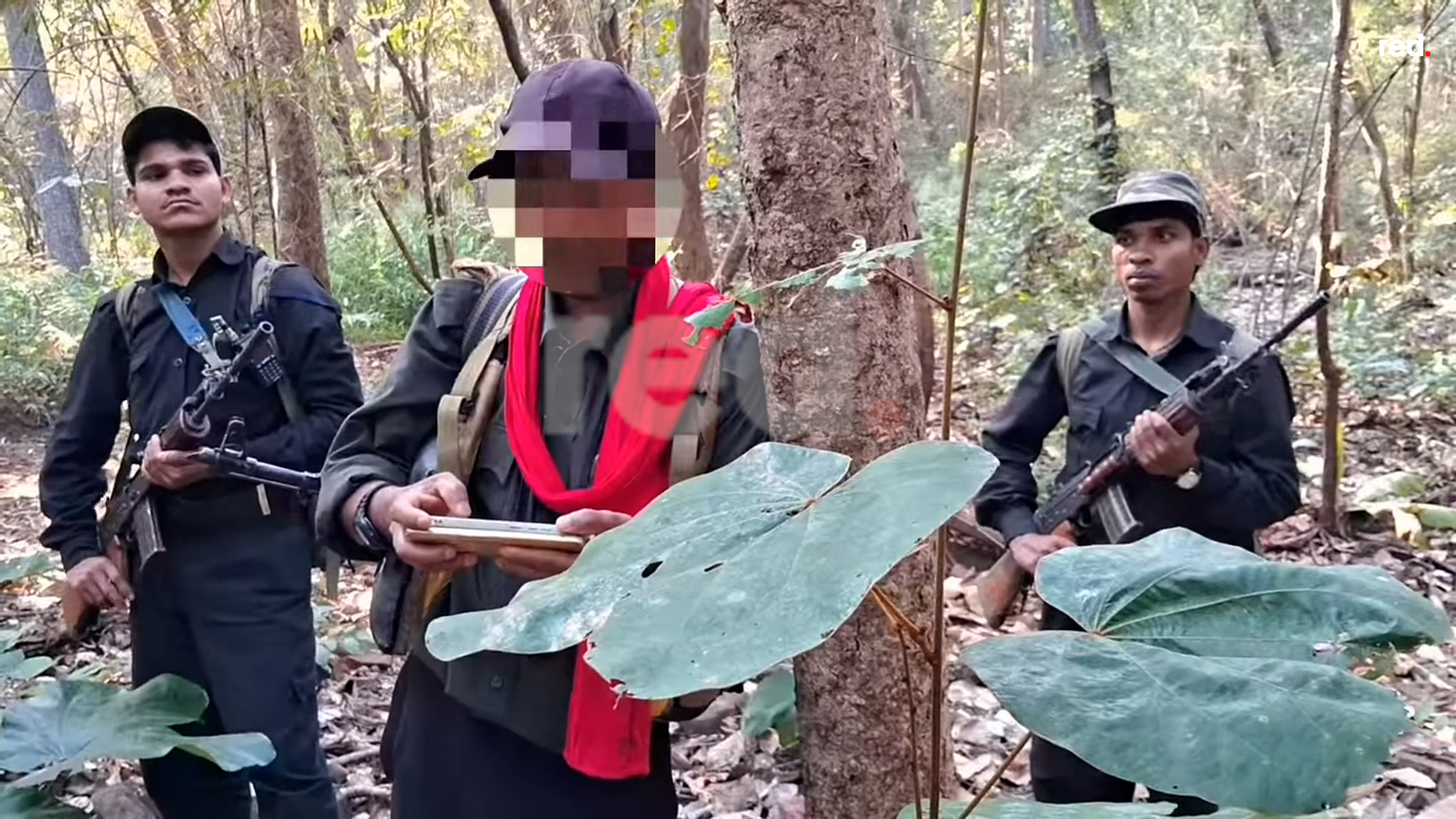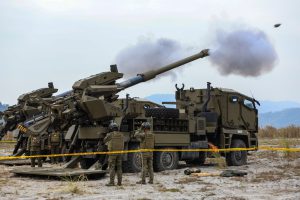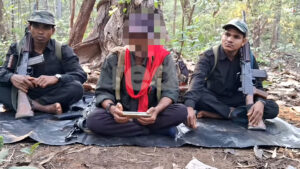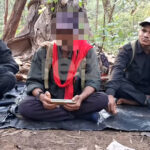Today’s people’s war in India is recognized as one of the most advanced revolutionary struggles in the world. Dubbed India’s biggest internal security threat by the Indian state, the Communist Party of India (Maoist) is a leading force combating the privatization of natural resources, exploitation of labor, and the promotion of Modi’s Hindutva agenda.
In an exclusive interview, we spoke with the party spokesperson Amrut, Central Committee Member and Head of International Affairs of the Communist Party of India (Maoist) about the unique conditions in India, the efforts to build a new society within guerrilla zones, and their perspectives on pressing questions facing the global left, including the character of China and the rise of new imperialist powers.
How long has the CPI (Maoist) been engaged in the people’s war in India, and what stage is this conflict currently at?
This is the fundamental question of the Indian revolution. To answer this, allow me to go back five decades in history. The history of people’s war in India is deeply rooted in the resounding period of the Great Proletarian Cultural Revolution (GPCR) of the ’60s, which was well known as a turbulent decade. It was the time when the two outstanding and front-ranking leaders of our streams—Comrades Charu Mazumdar and Kanhai Chatterjee —emerged on the scene in the course of applying Marxism-Leninism-Maoism (MLM) to the concrete conditions of India and by fighting, exposing, and breaking from the age-old revisionism of the Communist Party of India (CPI) and the neo-revisionism of the CPI (Marxist) brand.
The great Naxalbari revolt led by Comrade Charu Mazumdar in May 1967, was at the time hailed as the “Spring Thunder over India” by the Communist Party of China (CPC), proved to be the clarion call for revolutionaries. Under the revolutionary leadership of comrades Charu Mazumdar and Kanhai Chatterjee, thousands of cadres broke away from the neo-revisionist CPI (M) and joined hands with them. Comrade Charu Mazumdar formed the Communist Party of India (Marxist-Leninist), and Comrade Kanhai Chatterjee formed the Maoist Communist Centre (MCC). These two great Marxist teachers conducted a class analysis of Indian society and laid down the political strategy for the Indian New Democratic Revolution.
The political strategy of our party is armed agrarian revolution and the seizure of area-wide political power. The military strategy of our party is protracted people’s war (PPW). According to this strategy, we make the countryside our base areas, where the enemy is relatively weak, and then gradually encircle and capture the cities, which are the bastions of the enemy forces.
According to comrade Mao’s theory of PPW, there are three stages to capturing state power. At present, the Indian revolution is in the stage of “Strategic Defensive.”
The Indian state has been attempting to eliminate the CPI (Maoist) for decades, particularly through Operation Green Hunt. What is the current status of this military operation?
We must recognize that before the commencement of Operation Green Hunt, the Indian revolutionary movement had already faced severe repression and suppression campaigns in past decades. Our erstwhile parties, CPI(ML)(PW) and MCCI, faced fascist repression by the reactionary Indian state since the outbreak of the Great Naxalbari Armed Peasant Uprising. The first counterinsurgency campaign, “Operation Steeplechase,” began in the 1970s, and various repression campaigns were carried out by central and state governments in the ’80s and ’90s. With the merger of two revolutionary streams, our new Party, CPI (Maoist), was formed in 2004. Since then, the Indian State has declared it the single biggest internal security threat. From that time, the Indian State has been undertaking protracted counterinsurgency campaigns such as Salwa Judum, Sendra, Operation Green Hunt, Operation SAMADHAN, and in the beginning of 2024, the Indian State began a new military offensive campaign named “Operation Kagaar” (Final War), which is part of the reactionary Surajkund strategic counter-offensive operation plan. All these campaigns are part and parcel of the Low-Intensity Conflict, which is the strategy of US imperialists to crush worldwide people’s movements. More than 15,000 comrades of all ranks and files of our party and the People’s Liberation Guerrilla Army (PLGA), including revolutionary mass organizations and revolutionary people, have laid down their lives until now in the incessant killings by the police and in retaliating against fascist repression campaigns.
In the multi-polar world order, social-imperialist China is putting in immense effort to replace the dominant imperialist financial systems like the World Trade Organization and International Monetary Fund, with its own financial institutions.
Amrut – CPI(Maoist) Spokesperson
Operation Green Hunt is a continuation of these repressive campaigns. To cite a few examples from recent decades, there were Salwa Judum in Chhattisgarh, Sendra in Jharkhand, and the Peace March in Odisha in the first decade of the 21st century. These are all white terror campaigns organized by the Indian State and funded by big corporations. The Party, PLGA, revolutionary mass organizations, and Revolutionary People’s Committees, together with the revolutionary people, defeated these campaigns with their heroic resistance and enormous sacrifices. For the first time, the Indian state came out openly with an all-out counterinsurgency campaign throughout the country in the name of OGH in September 2009. The Indian State never acknowledged the commencement of any such campaign.
Operation Green Hunt continued for 10 long years and was reviewed after the Minpa ambush, in which a significant number of Central Armed Police personnel were annihilated. Then, a new operation named SAMADHAN began in May 2017. The Indian state announced SAMADHAN with a stipulated time period of five years to eliminate Maoists in the country. It reviewed SAMADHAN in October 2022 and introduced the reactionary Surajkund strategic offensive operation military plan (as we named it).
Currently, Forward Operational Bases (FOBs) are being established, and security is being intensified throughout the areas of the revolutionary movement. The deployment of armed forces, including the Indian Army under the guise of state forces, is on the rise. At present, there are about 700,000 government armed forces, including paramilitary, commando, state, and district forces, in the areas of the revolutionary movement. A police informer network is being built by the central paramilitary and state forces. To lend a humane face to its repression, Civic Action Programs (which are fake social service agencies) are being conducted by the police personnel. Additionally, there is the psychological war in the form of negative propaganda against the Party, PLGA, and revolutionary people’s committees, aimed at demoralizing and delegitimizing the Indian revolutionary movement.
The state has introduced several draconian laws such as the Terrorist and Disruptive Activities Act (TADA), Prevention of Terrorism Act (POTA), and the Unlawful Activities (Prevention) Act (UAPA), which was amended in 2018 by the Brahminical Hindutva fascist power in the Center, making the act even more draconian. It is being foisted on all those who express dissent against fascist rule. Political prisoners are repeatedly denied bail. Intelligence agencies have been significantly strengthened to crush the revolutionary movement. In recent years, the National Investigation Agency (NIA), which is a department under the central government, was given more powers under the guise of fighting terrorism. It is now being used against civil rights activists, artists, writers, students, teachers, and democratic and progressive forces under allegations of sedition. While Brahminic Hindutva Fascism is spreading its tentacles into all spheres of people’s lives, the exploited, oppressed, and harassed classes and sections are raising their voices and building movements against the fascist regime.
In an attempt to crush all these struggles and suppress those dissenting voices, the Indian state introduced a new term “urban Maoist” and then “pen-wielding Maoist,” in the name of which it is pursuing these forces. The NIA prepares a database of “terrorist activities.” A National Forensic Science University was established to create fake evidence of fake crimes. This has become the norm of the rule of law. From the second term of Narendra Modi’s government at the Center, aerial attacks are increasing on people in the struggle areas. Roads and communications are being laid on a large scale to facilitate the movement of police forces into the guerrilla bases. As already said, a new counterinsurgency campaign has been started by the Indian State in the name of Operation Kagaar to wipe out the leadership of the Maoist movement in the coming three years. For this purpose, thousands of additional forces are being deployed in the Maad region of Bastar, in the state of Chhattisgarh.
How does the Narendra Modi government differ from previous administrations? How have the CPI (Maoist) and PLGA experienced the changes under Modi’s leadership?
Yes! The current regime, which is under the leadership of Narendra Modi, is different from previous ones. Our Party recognizes that Indian feudalism is caste-based feudalism and Brahmanism is its ideology. All earlier governments were the representatives of the Indian ruling classes which comprise feudalists and the comprador bourgeoisie whose ideology is nothing but Brahmanism. But the current form of the Indian State, as per our Party’s understanding, is Brahmanic Hindutva Fascism. It is under the leadership of the RSS and BJP. At present, Narendra Modi is the key leader of Hindutva Fascism, and he has been the prime minister of India for a decade. The current BJP government wants to convert India into a Hindu-Rashtra (Nation) in the name of “New India,” which is nothing but comprador bourgeoisie-feudal fascism. The BJP government is not even allowing the functioning of “formal democracy,” and is gradually intensifying its attacks with each passing day.
The previous governments, which were under the leadership of Congress and the Congress-led alliance United Progressive Alliance, also implemented anti-people policies and ruthlessly crushed mass movements. All the Indian ruling class governments incurred enormous benefits to the ruling classes and their imperialist bosses. The Modi regime is implementing pro-imperialist policies more aggressively than earlier governments. At the same time, it is aggressively implementing the divisive Hindutva agenda.
After the BJP came to power in 2014, it intensified counter-insurgency programs against our party, the PLGA, the United Front, and the revolutionary masses. To eradicate our party and the revolutionary movement, the BJP government is carrying out suppressive policies throughout the country, particularly in our struggle areas. Their corporatization and militarization have become a new norm in an unprecedented way. Drone attacks and aerial bombings on revolutionary struggle areas and on tribal villages are the new norms under the BJP regime. Several abhorrent acts are being committed by security personnel with state impunity.
So, the Party, PLGA, and the United Front, the three “magic weapons” of revolution, are taking up several tactical programs to resist the Brahmanic Hindutva Fascism. Several mass movements under the guidance and leadership of our Party are building up in the revolutionary struggle areas against the policies of the Brahmanic Hindutva BJP government. Several heroic military actions were successfully carried out by our PLGA red fighters even after the BJP came to power in the Center. Recently, on January 16, 2024, our PLGA comrades, along with the involvement of hundreds of revolutionary masses, carried out a heroic raid on the Dharmavaram camp in the Bijapur district of Chhattisgarh as a response to the newly started Operation Kagaar by the Indian State. In this raid, 35 security personnel were eliminated and around 40 of them were seriously injured. While the repression and encirclements are escalating, resistance against it is also increasing.
India under Modi has a history of oppressing religious and ethnic minorities both physically and rhetorically. What is your party’s stance on this issue?
It is not Indian chauvinism but Hindu chauvinism. Yes. You are absolutely correct that the Modi government is demeaning religious and ethnic minorities and polarizing society. Our party understands that religious minorities, particularly Muslim communities, tribes, Dalit people, and women, are living as secondary citizens and need to unite against the Hindu chauvinism practiced by the Modi government for their emancipation. Our Party aims to organize them in the ongoing people’s war for their emancipation. The present government combines its Hindutva politics of casteism and communalism with corporatization in the interest of imperialists, the comprador bureaucratic bourgeoisie, and landlords. The BJP is utilizing religion as a powerful tool to stay in power and to create schisms in society. Using this religious tool, the BJP is diverting the masses from the real issues. The consecration of the Ram Temple in Ayodhya on January 22, 2024, is the perfect example of how the masses are being distracted from the severe political, social, and economic crises facing our country.
Our party stands with the principle of secularism, the right to religious freedom, freedom of speech, and hails the diversity of cultures and languages, food habits, etc. Whereas, Hindutva fascism is against all these democratic values.
Although it is a long way to success in the fight against patriarchy, the revolutionary movement and the revolutionary women’s movement have brought considerable changes in the situation of women in the guerrilla base areas.
Amrut – CPI(Maoist) Spokesperson
During the Naxalbari uprising of the 1960s, peasants killed large landowners and seized their lands. What role do peasants play in the CPI (Maoist) and the current struggle?
You have brought up the past practices of our party which upheld the left adventurist line of annihilation of the class enemy as the only path to success in the Indian agrarian revolution. We have already rectified that wrong practice. We uphold the Marxist principle of worker-peasant unity. Let us come to your question. India is an agriculture-based country. Peasants constitute the majority of the country’s population. Peasants also constitute the majority in the Party, PLGA, revolutionary mass organizations, and revolutionary people’s committees. In that sense, peasants are part of the social, political, military, and economic aspects of the ongoing people’s war. All the heads of the party committees, militias, and the organs of people’s state power at the local level are peasants. Currently, the majority in the PLGA are tribal peasant comrades and are leading platoons, companies, and battalions.
Peasants are involved in every activity of the agrarian revolutionary program, such as the distribution of land to the tiller. Under the leadership of our party, the revolutionary people’s committees are working for the people’s welfare by undertaking programs such as land leveling, construction of embankments, laying of ponds and bridges, and developing village connectivity to improve productivity. We are giving special importance to practicing collective cooperative methods of work. Our PLGA guerrillas and party cadres unite with the masses in all their production activities.
In the areas controlled by CPI (Maoist), how is society organized and what does your party do differently from the government?
As per the above-mentioned strategy followed by our party for making revolution, we start from the interior tribal areas, extend to the plain areas forming organs of people’s state power, and finally seize power in cities of the enemy’s stronghold. The tribal society is feudal, where the head of the village has the say. With the changes brought through the revolutionary movement, the village heads no longer have power. The local party committee, comprised of poor and middle-class peasants, leads the village. In the plain areas, the society is mainly Brahmanic Hindutva with a minority of other religions.
The ruling exploitive government speaks a lot about people’s welfare but does nothing. The peasants lack minimum requirements for farming such as irrigation, seeds, and agricultural implements. The revolutionary people’s committees look after the needs of the peasants and focus on raising the yield. The exploitive government is not in the least bothered to run schools and hospitals for tribal people. The revolutionary people’s committees are running local schools. Every local government has a medical department and a doctor. The concerned party committee has a budget for schools run by the revolutionary people’s committees. The doctors from PLGA impart training to the revolutionary people’s committee doctors. The cottage industry department is yet to become active so as to help the people in selling the forest produce and purchasing daily needs in the market.
We are working against a semi-colonial, semi-feudal, strong state that is backed by imperialists. As per our strategy, we build revolutionary people’s committees wherever we succeed in bringing down the exploitive government. We thus build area-wide organs of state power, gradually extending and strengthening them. The guerrilla bases are enduring even amidst a lot of massacres, killings of leaders and activists of party committees, militias, revolutionary people’s committees, and sexual atrocities on women. We now hold power on a very small level. So, there are limitations to the development activities that we take up.
What is the influence of the caste system in the areas you’ve liberated? How is the party challenging feudal structures and societal attitudes?
There are as such no liberated areas until now. There are base areas in special guerrilla zones that we seek to unite and liberate. The caste system is one particular feature of Indian society, and communalism is another that is linked to it. It is part of Brahmanic Hindutva’s Chaturvarnya system and is rooted both in the base and superstructure of the present society and is dialectically entwined in both spheres. Caste is meant to divide the people to facilitate exploitation and oppression of the working classes. It is not an easy task to eliminate it. It is linked with the success of the New Democratic Revolution and construction of the socialist state. The fight to eliminate caste is part of the agenda of the party and the revolutionary mass organizations. We fight both in the base and the superstructure to eliminate caste. Coming to the guerrilla zones, caste does not exist in tribal society where we are based, per our strategy. However, it is reflected in the form of differences in the status of different tribes. Whether it is in the tribal, plain, or urban areas, uniting people is the main activity. We work to unite all the toiling castes to isolate the enemy classes.
How is your party combatting patriarchy?
Although it is a long way to success in the fight against patriarchy, the revolutionary movement and the revolutionary women’s movement have brought considerable changes in the situation of women in the guerrilla base areas. Patriarchy in tribal society manifests in various forms such as forced marriage, bigamy, polygamy, and wife-beating. The party and the women’s organizations have educated the society that all these patriarchal attitudes are negative not only to women, but they also hinder social development as a whole. Women are part of party committees, the three forces of PLGA namely the main, secondary, and base forces (meaning militia), and the revolutionary people’s committees and revolutionary mass organizations. Women are working in all spheres of activity in the movement such as party building, military offensives, people’s welfare, communications, and manufacturing arms.
Has the Modi government changed the socioeconomic conditions in India? Some suggest that India is now an imperialist power.
The Modi government only worsened the socioeconomic conditions of the people of the country. Peasants are losing farmland and tribal people are being displaced from their forests for corporations. Food crisis, unemployment, and displacement are growing at an alarming rate. Agriculture, industry, and manufacturing sectors have been privatized. People are being deprived of their fundamental needs of life. Health care is almost nil for the poor classes. Pandemics are taking the lives of poor people in large numbers. The majority of the people are in a state of misery. The people’s struggles in the country reveal the actual situation.
Modi has been using religion as a way to distract people from the conditions the vast majority is living in. In doing so, he has been diluting the diversity of our country in the name of Hindutva. To saffronize the country, he is attacking the Indian constitution, which promised the Indian people a secular government. Modi’s government is bulldozing the houses of Muslim communities. In the name of “cow protection,” it is lynching Muslims, Dalits, and Adivasis in broad daylight. Hate speech is being aired through government-supported mainstream media channels.
All the talk about India becoming the “third biggest economy” is a big sham. The country is experiencing growth in unemployment. In fact, the parameters with which the government claims “progress” in the economy are not accepted even by bourgeois economists. For example, the growth in the GDP of the country. The criticism is that it is not correct to include the investments of foreign corporations to measure GDP. The government is helping members of the comprador bureaucratic bourgeoisie such as Adani and Ambani. Indian society is witnessing a deep breach in social harmony with the deliberate deeds of Brahmanic Hindutva on the basis of religion and caste, in its bid to serve the domestic comprador class and its master, the imperialists. The heavy technological development benefits the crony capitalists who serve the imperialists while more than half of the population lives below the poverty line. India is dependent on imperialist capital, import of technology, and capital goods. It has no characters of imperialism and cannot be labelled “imperialist.” India is still a semi-colonial, semi-feudal country.
India is a member of the Shanghai Cooperation. How do you evaluate this cooperation, which includes Russia, China, Brazil, and South Africa?
In 2006, it was estimated that the total value of bilateral trade was of the order of $20 billion. As China developed new forms of political relations with its central Asian neighbors, bilateral meetings on border and trade issues were found to be inadequate to deal with the rapidly changing geopolitical environment. Political Islam became more and more influential in Afghanistan and Tajikistan, and the new governments of Uzbekistan and Kyrgyzstan considered it a serious threat to their authority. All of the regional powers perceived that despite great differences between them, they had a common interest in combating this new force which they all saw as a threat to the stability of the region.
The first meeting of what was to become a major regional grouping took place in Shanghai in 1996 when the foreign ministers of China, Russia, Kazakhstan, Kyrgyzstan, and Tajikistan met to discuss common concerns. An agenda was constructed around the issues of border security and how to combat insurgent Islamic forces. The group, which planned to meet on a regular basis, was first known as the Shanghai Five but was later renamed the Shanghai Cooperation Organization in June 2001 when Uzbekistan was admitted. The new name was sufficiently flexible to allow for the admission of other members. Pakistan, the only other state being seriously considered for membership, was not permitted to join.
Since the British left India, the ruling classes of India have been trying to be close to all the imperialist countries. It continued to serve Britain and later developed close ties with the US. When the Soviet Union was strong, India was close to it. It is now close to China and its alliance, the Shanghai Cooperation. It is also part of BRICS, led by China and Russia. India has enormous natural and human resources and a large market due to a huge population that attracts capitalists from all over the world. India is characteristically governed by the comprador bureaucratic bourgeoisie and Big Landlords. Therefore, its membership in the alliance is part of a foreign policy in line with its comprador interests. The expansionist attitude of the Indian ruling class is also one reason for it joining the alliances. In 2017, India became a member of the rising imperialist alliance, BRICS. Today, in the multi-polar world order, social-imperialist China is putting in immense effort to replace the dominant imperialist financial systems like the World Trade Organization and International Monetary Fund, with its own financial institutions. India is nothing but a poster-boy of US imperialism in BRICS and the Shanghai Cooperation Organization.
I want to emphasize that US imperialism remains the primary enemy of the oppressed people and nations. But that in no way means that social-imperialist China and other imperialist countries should not be fully opposed. The ruling class of China has kept busy with the propaganda of “socialism with Chinese characteristics,” which is nothing but imperialism with Chinese characteristics.
India’s expansionism can be seen in Sri Lanka where it helped the ruling class crush the national liberation movement; in Nepal where the Indian comprador bureaucratic bourgeoisie has invested in the tourism industry; in Myanmar where it helps the ruling class crush the Rohingya Muslim organizations; and similar activities in other neighboring countries.
India is nothing but a poster-boy of US imperialism in BRICS and the Shanghai Cooperation Organization.
Amrut – CPI(Maoist) Spokesperson
What is your opinion on the concept of “socialist China” and “socialism with Chinese characteristics,” as propagated by the Chinese government, activists, parties, and journalists?
China ceased to be a socialist country since the late 1970s. Our party considers that China became a social-imperialist country around 2014. “Socialism with Chinese characteristics” is nothing but a false claim of the present imperialist ruling class of China. A few comrades are not clear about the imperialist characteristics that China attained in the process since the restoration of capitalism. In 2017, our party released a document titled China, a New Social-Imperialist Power: It is integral to the world capitalist-imperialist system explaining our analysis of China. Leaving aside facts and figures, the economic, political, social, and cultural policies of the ruling class of China are clearly imperialist.
China is therefore neither a socialist nor communist country. It is a social-imperialist country. The facts that shows this are that monopoly capitalism and financial oligarchy are on the rise. Capital is accumulated in a big way. Finance capital rules. China is investing capital in almost all parts of the world. It is contending with the US for world hegemony. It is leading alliances such as the Shanghai Cooperation and BRICS, together with Russia, in its attempt to redivide the world to exploit raw materials and markets.
How does today’s China differ from China during Mao’s time?
Mao led the Communist Party of China and continued waging socialist revolution even under the proletarian dictatorship through the Great Proletarian Cultural Revolution (GPCR). GPCR is a great contribution of Mao. This was a theoretical political struggle and a great upsurge of the revolutionary masses. The objective of GPCR was to continue the revolution in all the fields of the superstructure in order to advance the socialist economic system towards the construction of a communist society. It’s goal was to absolutely eliminate the possibilities of the restoration of the classes overthrown in the New Democratic Revolution (the big landlord and comprador bureaucratic bourgeois classes serving imperialism) and to continue the dictatorship of the proletariat by thwarting the attempts of the enemy classes to reinstate capitalism.
The GPCR also had the immediate aim to end revisionism, employ the mass strength in a struggle based on mass line to remove the capitalist roaders settled in the party leadership and party organization. This was a tortuous class struggle against the capitalist roaders and the continuation in China of the worldwide struggle against modern revisionism. It could contain restoration of capitalism for 10 years. Due to a lot of mainly internal and a few external factors, capitalism was restored later. Today, China is a social-imperialist country.
Some describe the current moment as a critical juncture for the global left. What are your thoughts on this?
The revolutionary forces were never at a crossroads, whether it was in the period after Stalin’s death in the Soviet Union, or Mao’s death in China, or when it was influenced by Soviet revisionism and Deng’s revisionism. When Khrushchev and his revisionist clique took over power in the Bolshevik party and the Soviet government in the mid-1950s, it was for capitalist restoration. China was then in the construction of socialism. The Communist Party of China (CPC) under the leadership of Comrade Mao Zedong took up a theoretical struggle against the modern revisionism of Khrushchev, that came to be known as the “Great Debate” in the International Communist Movement.
Eastern European countries such as Yugoslavia took to Khrushchev’s revisionism and left the path of socialist construction. Mao also gave an analysis as to why the Soviet Union failed to go forth in socialist construction. Mao took lessons from the Soviet Union and applied them in China. The CPC under his guidance called for the Great Proletarian Cultural Revolution, which contested capitalist restoration for a decade. Later, when Deng took over the reins of the CPC and the People’s Government of China, he led a counter-revolution to restore capitalism. Since then, there has been no socialist base in the world.
Capitalism was restored in both countries because the contradiction between capitalism and socialism was not resolved. This is the process of struggle in which society progresses, from feudalism to capitalism and then to socialism, and finally to communism. All countries of the world need to take these lessons to make a successful revolution. The proletarian parties that bear this understanding are working to accomplish revolution in the concrete conditions of their respective countries.
Is there anything else you’d like to add?
Lastly, I wish to express solidarity from our party to the ongoing people’s wars, national liberation movements, and anti-imperialist struggles of the world. I wish to appeal to all these forces to come together in revolutionary activity to root out imperialism from the earth and establish socialism and then communism all over the world. The time is ripening. Let us act bravely. Let us achieve victory. Workers of all countries, unite!





